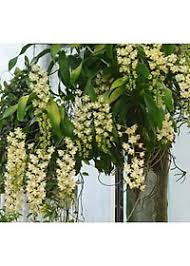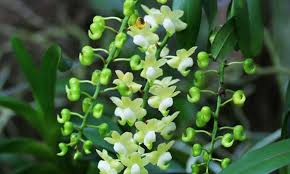
Orchids are among the most diverse and enchanting flowering plants in the world, with thousands of species and hybrids that captivate enthusiasts and gardeners alike. Among the most sought-after varieties are the Da Châu orchids (*Rhynchostylis gigantea*) and Vanda orchids, known for their unique beauty and vibrant colors. While both belong to the same family, they exhibit distinct characteristics in terms of appearance, growth habits, care requirements, and cultural significance. This article will explore the differences between Da Châu orchids and Vanda orchids in detail, helping you better understand and appreciate these magnificent plants.
## 1. Botanical Classification
### 1.1 Da Châu Orchids
Da Châu orchids, scientifically known as *Rhynchostylis gigantea*, belong to the family Orchidaceae and are native to Southeast Asia, particularly in regions like Thailand, Laos, and Vietnam. This species is known for its epiphytic nature, which means it grows on other plants without harming them, deriving moisture and nutrients from the air and rain.
### 1.2 Vanda Orchids
Vanda orchids, on the other hand, belong to the genus *Vanda*, which encompasses various species and hybrids. These orchids are also part of the Orchidaceae family and are primarily found in tropical Asia, with a significant presence in Southeast Asia, India, and parts of Australia. Vanda orchids are known for their striking flowers and can be either terrestrial or epiphytic, although most prefer to grow as epiphytes.
## 2. Physical Characteristics
### 2.1 Flower Structure and Colors
#### Da Châu Orchids
– **Flower Size and Shape:** Da Châu orchids typically produce large, fragrant flowers that can reach up to 5-6 cm (2-2.5 inches) in diameter. The flowers have a unique star-like shape, characterized by broad petals that often have a distinct pattern.
– **Color Variations:** The flowers are available in various colors, including white, pink, and shades of purple, with some varieties showcasing vibrant red or yellow patterns. The distinctive color combinations and patterns make Da Châu orchids highly sought after.
#### Vanda Orchids
– **Flower Size and Shape:** Vanda orchids are renowned for their large, flat flowers that can measure up to 10-15 cm (4-6 inches) across. The flowers typically have a more open appearance than Da Châu orchids, giving them a more delicate look.
– **Color Variations:** Vanda orchids come in an extensive range of colors, including blue, purple, yellow, orange, and white. Many Vanda hybrids exhibit intricate patterns and markings, making them particularly popular among collectors.
### 2.2 Foliage
#### Da Châu Orchids
– **Leaf Structure:** Da Châu orchids have thick, leathery leaves that are typically dark green in color. The leaves are arranged in a rosette pattern, creating a lush appearance that contributes to the plant’s overall beauty.
– **Growth Habit:** Da Châu orchids can reach a height of about 60-90 cm (24-36 inches), with a compact growth habit that makes them suitable for various display settings.
#### Vanda Orchids
– **Leaf Structure:** Vanda orchids also have long, strap-like leaves that can reach lengths of 30-90 cm (12-36 inches). The leaves are usually a lighter shade of green and have a more upright, arching growth habit.
– **Growth Habit:** Vanda orchids can grow quite tall, often exceeding 90 cm (36 inches) in height. They are generally more open and sprawling than Da Châu orchids, making them a striking addition to any garden or indoor setting.
## 3. Growth Requirements
### 3.1 Light
#### Da Châu Orchids
– **Light Preference:** Da Châu orchids thrive in bright, indirect light. They can tolerate some direct sunlight, especially in the morning or late afternoon, but prolonged exposure to harsh sunlight can cause leaf burn.
– **Lighting Conditions:** Ideal lighting conditions for Da Châu orchids mimic their natural habitat, which is often found in dappled sunlight under the canopy of trees.
#### Vanda Orchids
– **Light Preference:** Vanda orchids require more intense light compared to Da Châu orchids. They thrive in full sun to partial shade, making them suitable for outdoor cultivation in tropical regions.
– **Lighting Conditions:** To achieve optimal growth, Vanda orchids should receive at least 6 hours of bright light daily. Indoor growers often use grow lights to supplement natural light during darker months.
### 3.2 Watering
#### Da Châu Orchids
– **Watering Needs:** Da Châu orchids require consistent moisture but are sensitive to overwatering. It is essential to allow the potting medium to dry out slightly between waterings.
– **Watering Technique:** Water the plant thoroughly until water drains from the bottom of the pot. Reduce watering frequency during the winter months when the plant is dormant.
#### Vanda Orchids
– **Watering Needs:** Vanda orchids have higher water requirements than Da Châu orchids, especially during the growing season. They thrive in consistently moist conditions.
– **Watering Technique:** Water Vanda orchids daily or every other day during hot weather, ensuring that the roots remain hydrated without sitting in water.
### 3.3 Humidity
#### Da Châu Orchids
– **Humidity Preference:** Da Châu orchids prefer moderate humidity levels, ideally between 50-70%. This range helps to maintain healthy foliage and vibrant blooms.
– **Humidity Management:** Humidity can be increased by misting the plant regularly or placing it on a pebble tray filled with water.
#### Vanda Orchids
– **Humidity Preference:** Vanda orchids thrive in higher humidity levels, typically between 60-80%. This high humidity is crucial for promoting robust growth and flowering.
– **Humidity Management:** Using a humidifier or placing the orchids in a naturally humid environment, such as a greenhouse, can help maintain the desired humidity levels.
## 4. Fertilization
### 4.1 Da Châu Orchids
– **Fertilizer Type:** Da Châu orchids benefit from a balanced orchid fertilizer with a nutrient ratio of 30-10-10 during the growing season. This ratio provides adequate nitrogen for leaf growth and promotes blooming.
– **Fertilization Schedule:** Fertilize every 2-4 weeks during the growing season and reduce or eliminate fertilization during the winter months when the plant is dormant.
### 4.2 Vanda Orchids
– **Fertilizer Type:** Vanda orchids thrive on high-nitrogen fertilizers, with a recommended ratio of 30-10-10 or similar during the growing season. Some growers also use specialized fertilizers designed for Vanda orchids.
– **Fertilization Schedule:** Fertilize Vanda orchids every 1-2 weeks during the growing season and reduce feeding during the winter months.
## 5. Propagation
### 5.1 Da Châu Orchids
– **Propagation Method:** Da Châu orchids are typically propagated through division or keikis (small plantlets that grow on the flower spike). When propagating through division, it is essential to ensure that each division has a healthy root system.
– **Timing:** The best time to propagate Da Châu orchids is in the spring, just before the growing season begins.
### 5.2 Vanda Orchids
– **Propagation Method:** Vanda orchids are most commonly propagated through seed germination or tissue culture, as they do not produce keikis as frequently as other orchid types. Due to their specific growing requirements, propagation through seed germination is best suited for experienced growers.
– **Timing:** Like Da Châu orchids, spring is the ideal time for Vanda orchid propagation, as this aligns with their natural growth cycle.
## 6. Common Pests and Diseases
### 6.1 Da Châu Orchids
– **Common Pests:** Da Châu orchids can be affected by pests such as aphids, mealybugs, and spider mites. Regular inspections and preventive measures, such as insecticidal soap, can help manage pest populations.
– **Diseases:** Fungal diseases, such as root rot, can occur if the plant is overwatered or if there is poor air circulation. It is essential to provide proper care and monitor for signs of disease.
### 6.2 Vanda Orchids
– **Common Pests:** Vanda orchids are also susceptible to similar pests, including scale, mealybugs, and aphids. Maintaining a healthy environment and using organic pest control methods can minimize infestations.
– **Diseases:** Vanda orchids are particularly prone to fungal infections due to their preference for high humidity. Proper airflow and avoiding excessive moisture on leaves can help prevent these issues.
## 7. Cultural Significance and Uses
### 7.1 Da Châu Orchids
– **Cultural Importance:** In Vietnamese culture, Da Châu orchids symbolize love, beauty, and admiration. They are often used in floral arrangements for special occasions, celebrations, and religious ceremonies.
– **Uses in Landscaping:** Da Châu orchids are popular for ornamental gardening and are often displayed in pots or as part of garden arrangements, where their vibrant colors can enhance the aesthetic appeal of outdoor spaces.
### 7.2 Vanda Orchids
– **Cultural Importance:** Vanda orchids hold significant cultural value in many Asian countries. They symbolize beauty and elegance and are often associated with luxury and high status. In Thailand, for instance, they are recognized as the national flower.
– **Uses in Landscaping:** Vanda orchids are frequently used in landscaping, floral arrangements, and as cut flowers due to their long-lasting blooms and striking appearance. They are ideal for tropical gardens and can be displayed in various ways, including hanging baskets.
## 8. Conclusion
In summary, while both Da Châu orchids and
Vanda orchids belong to the same family, they exhibit distinct differences in their botanical classification, physical characteristics, growth requirements, and cultural significance. Da Châu orchids are known for their star-like flowers and compact growth habit, while Vanda orchids are celebrated for their large, flat blooms and vibrant colors. Understanding these differences can help orchid enthusiasts choose the right plants for their collection and provide the appropriate care to ensure their health and longevity. Whether you prefer the delicate beauty of Da Châu orchids or the striking elegance of Vanda orchids, both varieties offer a captivating addition to any orchid lover’s garden.


